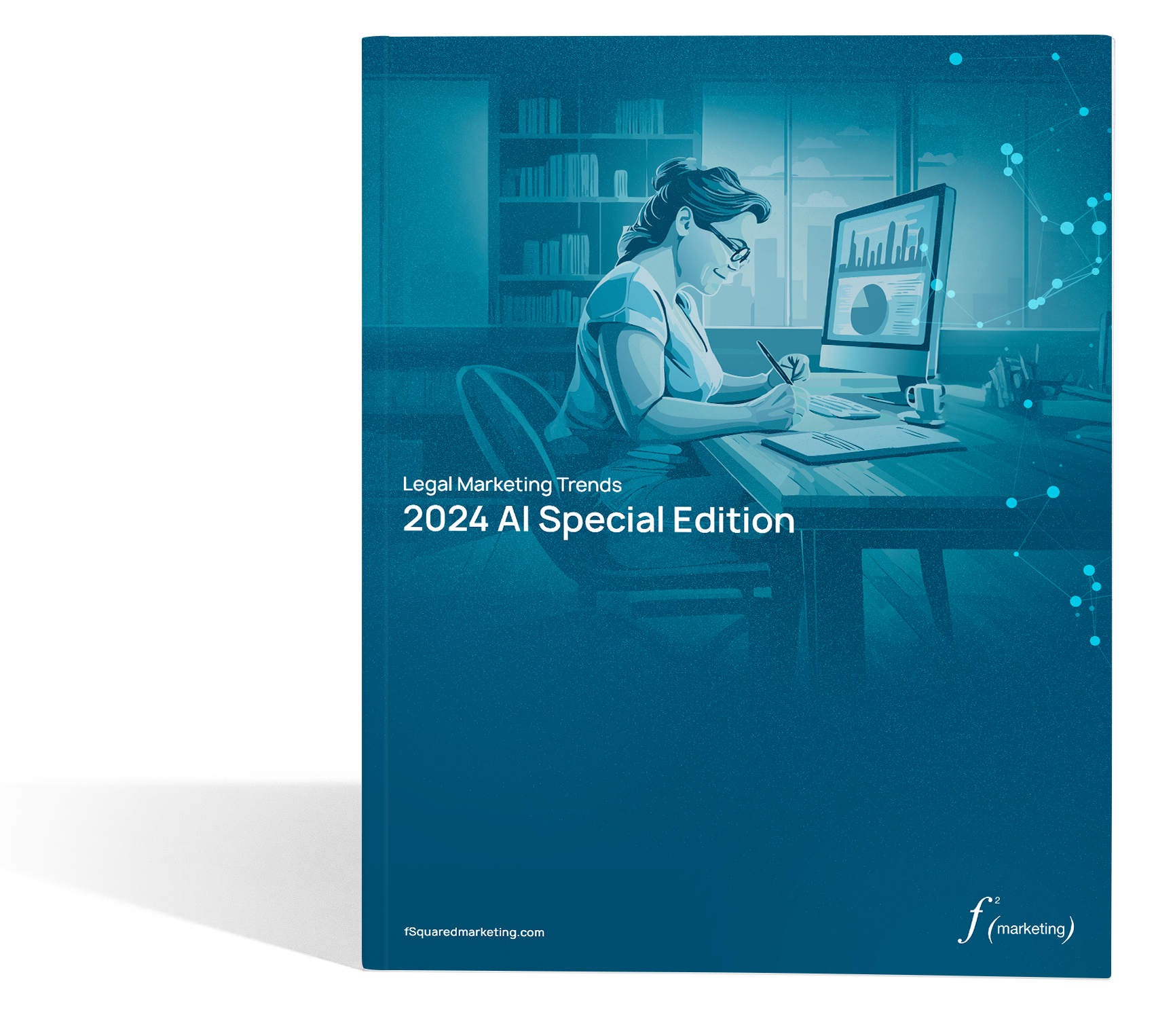Legal Marketing Trends 2024 – AI Special Edition
Introduction

Lynn Foley
CEO
fSquared Marketing
As we publish this new edition of Legal Marketing Trends, I’m excited to share voices from our field on the impacts of artificial intelligence (AI).
Generative AI (GenAI) and Large Language Models (LLMs) have rapidly begun to impact our industry, reshaping how we provide insights and craft customized marketing strategies. Over the past year, leaders in our field have participated in conversations about AI, highlighting its growing influence and opportunities.
What excites me most about AI is its potential to enhance both the strategic and creative sides of our profession. Imagine quickly analyzing data or generating compelling, tailored proposals with ease. AI tools enable us to deliver more value to our clients and stay competitive.
As always, when it comes to innovating with new technologies it’s essential to strike the right balance when it comes to risk and caution. AI supports, but does not replace, the incredible work we do. Ethical considerations and accuracy remain paramount, especially in the legal industry.
The enriching conversations we’re capturing in this special edition of Legal Marketing Trends have helped us explore practical AI applications while considering its future potential. By thoughtfully integrating AI into our workflows, we can boost productivity and creativity without losing the human touch that defines our work.
Looking ahead, continuous learning and adaptation will be key to enduring success. Together, we can ensure AI serves as a valuable tool, augmenting our capabilities and helping us achieve greater heights in legal marketing and business development.
In producing this report, our team has used AI selectively as part of the creative process to generate graphics and text to engage you as our audience. As you read these insights, I hope you will find the inspiration – as I have – to continue exploring, learning and innovating together with the legal marketing community as a whole.
Quick Insights
“AI isn’t necessarily going to replace marketers, but marketers who use AI will ultimately replace marketers who don’t. There are principles in marketing that will never change. For example, knowing who your clients are, their needs, and delivering value will remain with or without AI. But how you uncover and deliver on those principles will change dramatically with the use of LLMs and AI tools. It is paramount that legal marketers upskill and prepare for the next phase of legal marketing because it’s already upon us. But most importantly, marketers should not feel threatened by AI. The goal of leveraging AI for marketing will always be to enhance the work great marketers are already doing.”

Jessica Aries
Digital Marketing Strategist + Consultant
By Aries
“I firmly believe that Artificial Intelligence (AI) is not just a futuristic concept but a pivotal tool in transforming legal marketing and business development – as well as the practice of law. AI enhances our capacity to analyze vast amounts of data, providing insights that drive more personalized and effective marketing strategies. Furthermore, if used properly, AI can streamline operations, enabling us to predict market trends and client needs with unprecedented accuracy. In harnessing the power of AI, we’re setting a new benchmark for innovation in legal marketing and ensuring that our clients stay ahead in a competitive landscape. The integration of AI in legal marketing is not an option; it is a necessity for any firm aiming to innovate, grow and succeed in the modern digital arena.”

Gina Rubel, Esq.
CEO & General Counsel
Furia Rubel Communications, Inc.
A strategic deployment of GenAI in the legal field starts with understanding which tasks will benefit the most from its power. Legal experts should prioritize AI in areas where risks are minimal and benefits are clear, always ensuring compliance with professional ethical standards and obligations to clients.
Two such areas are business development and marketing, where AI isn’t just useful; it’s a game changer. These fields demand integrating company data into tailored proposals and content that excite and resonate with potential clients. AI-enhanced software can help personalize proposals effectively, making them more compelling for prospective clients and supporting strategic business development in a competitive legal market.
Firms that successfully incorporate GenAI into their workflows can enhance the speed, accuracy, and cost-efficiency of their work. By leveraging GenAI, organizations can expedite legal research, contract analysis, and document creation, resulting in quicker turnaround times and improved client service.
However, when it comes to legal briefs or documents that cite case law, tread lightly, because legal accuracy is nonnegotiable. While GenAI can help create first drafts of documents, it’s still considered general best practice not to use AI-generated content without careful due diligence and review.

Ray Meiring
CEO & Co-Founder
QorusDocs

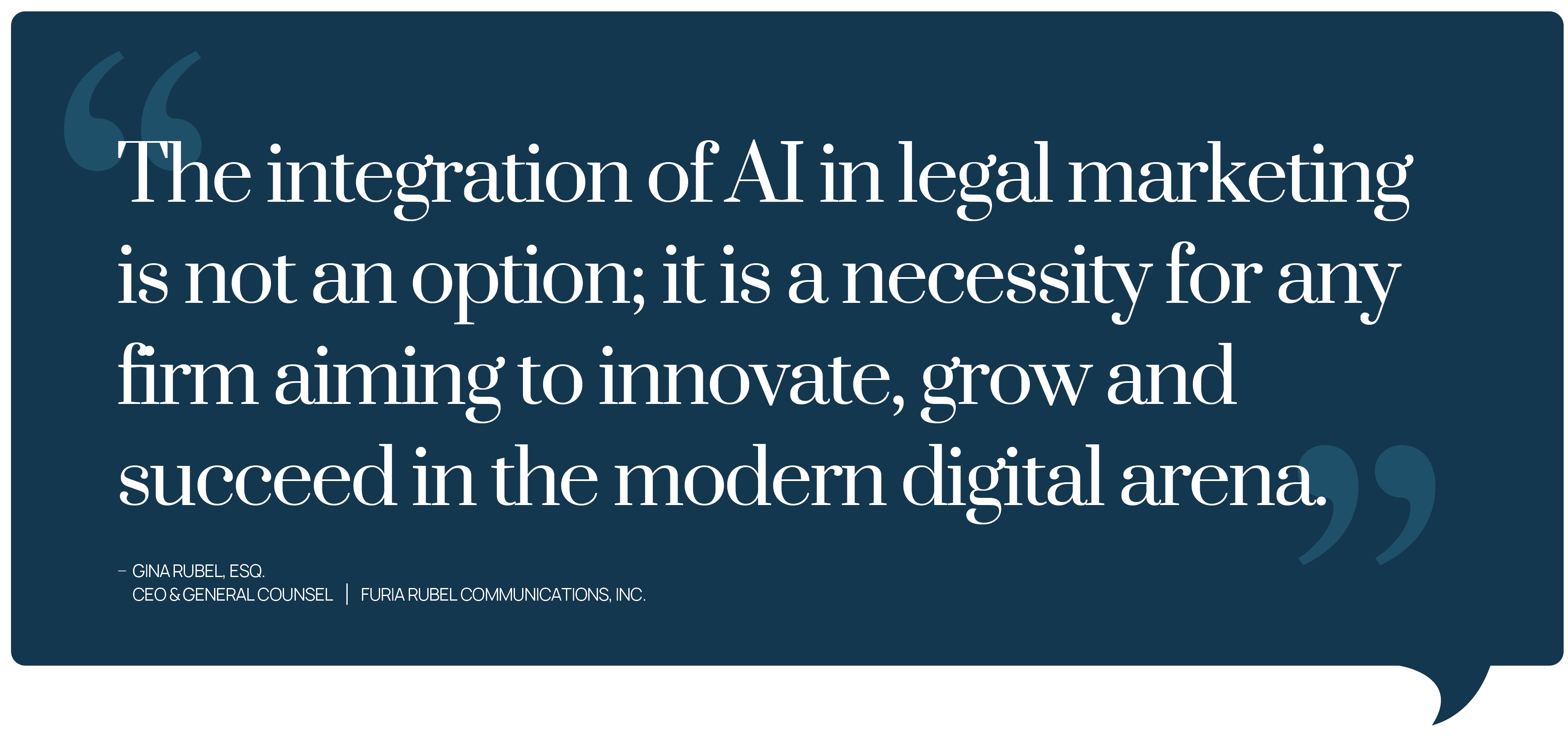
Conversations with the Experts

AI for PR, Marketing & Business Development

Liz Hershman
Senior Vice President
iQ360
All of us who work in law firm communications know that, historically, law firms tend to be risk-averse when it comes to innovation. At the same time, all of us are here because we know that AI will continue to be an absolute game-changer for communicators in every industry. Some of you may be experimenting by using AI to convert notes into a blog post, for example, or to generate a framework for a thought leadership platform or even using derivative AI to create multiple pieces of fresh content from one attorney interview. Those are all extremely promising applications, but of course we also have to worry about things like inherent bias and protecting sensitive data, and ultimately – what I think is maybe the biggest concern – managing our firms’ reputations in an era where it will be a lot harder to track down and correct misinformation.
—
Innovation & Learning

Andrew Medeiros
Director of Innovation
Troutman Pepper
The route we’ve taken as a firm is to provide our attorneys and business professionals at every level with a broad platform they can use for a lot of different tasks. Athena is our generative AI platform. In the future, there will be specific purpose-built and purpose-driven solutions. However, we wanted to get this in the hands of our people sooner rather than later – so they can understand the ways it can work for them, how it can work for our clients, and the risks associated with it, and learn from those early rather than trying to catch up later.
The rollout has been fantastic. What we must keep in mind – and we’re open and honest and public about this – is most technologies at a law firm don’t get used by everybody. They get used by those who are really interested and engaged and bought into the platform. So, we’re working on broadening that base. What we’ve learned so far: About one third of our employees have used Athena and use Athena regularly. We’re working on getting out to the rest of the teams to understand the hesitancies, aversions, and how we overcome them.
Athena has been out for almost a year now, and I still feel like we’re experimenting constantly. One third of our firm has adopted it, but that means two thirds haven’t. So, we’re still fighting that battle and still working toward that. Which is something that I think everyone should keep in mind.
Let’s talk about the future for legal marketers with AI, especially for junior level people who need to learn to become senior. What do you think the future’s going to look like for us as communicators?
Judgement and discretion are going to be important. To some extent, anybody can get any type of tone or any type of response out of AI, but having that judgement and discretion and to know which tone to use and which
formulation to use in certain circumstances is something that comes with experience over time. How do we get them there? To some extent, it depends on firms and companies choosing to invest in people over time just like they choose to invest in technology. You must invest in the people or you’re just going to be two people running a law firm and printing out money, but what’s the long-term success and long-term viability of that? And, when you then factor in that the firm doesn’t have long-term viability, what clients are going to trust you? There’s this perpetual hamster-wheel effect. We must have people who can continue to get these jobs done in a way that is effective and safe and compliant and reasonable. And the only way to do that is to bring young people in and teach them how to do it, and grow them up.
How do you start if your firm hasn’t dipped their toe into AI? How can small, mid-size or boutique firms compete?
I think the answer is: “Go out and do it.” Certainly not with your client data. And not necessarily with your work and with anything professional. But, even as a marketing person in a small law firm who doesn’t have access to AI on your firm technology right now, go off on your own – separate from work, doing personal stuff – but use AI platforms that are publicly available in your day-to-day life, organizing kids’ activities, or your book club, or your volunteer organizations. Use it in your life, so you can understand how it works, and so you can be better informed, so that: Number one, you can come to work with ideas to pitch and start selling the higher-ups on how you would do it. Number two, as technologies advance, the price will come down, and when it gets to that point when your firm is ready, you’ve made the business case and your firm does make the investment, you’ll hit the ground running because you have all this background knowledge from your personal life. It’s just like the kid who grows up coding for fun, and then can do it professionally. We all must go out and invest that time personally to become familiar with these technologies and how they work.
—

A Synopsis of the Space

Micah Buchdahl
Attorney
HTMLawyers
If your marketing team is using generative AI to draft content, there are a number of legal ethics issues you need to make yourself aware of. Among the things to look at are inappropriate or outdated terminology, deep fakes and hallucinations, and fake citations.
If we’re using AI for a blog post, for example, how are we assured of its truth or accuracy? You also need to pay attention to IP issues and copyright infringement, plagiarism, duplicative content.
Attorneys must ensure that any content they publish is accurate and complies with the specific state’s ethics rules. In a perfect world, you would be treating content with the same compliance review as anything else you might publish.
My primary concern in this space is UPL – unauthorized practice of law – when I’m reviewing marketing campaigns for ethics compliance. Not just compliance with advertising rules in a state, but whether you’ve crossed state lines or opened yourself up to oversight in an unwanted jurisdiction.
Beyond that, look at your own law firm’s guidelines:
- What’s the firm’s policy on AI use?
- How does your AI platform differentiate between internal data and external data?
- What do you disclose to clients?
- Do you get client consent? Everybody’s different in terms of their approach there.
- Review AI-generated content for accuracy, misleading statements, predictions of success, improper comparisons, or “legal advice.”
- Are you complying with federal and state laws?
Another area that’s important is possible disclosure of AI in your advertising. I’ve now added disclaimer language to some of my marketing campaign analysis in terms of disclosing use of AI that in the past I may have previously disclosed in terms of how it relates to dramatization or photos, depicting clients or lawyers or not.
And finally, there is the use of chatbots on your website. That’s another area that’s important to keep an eye on. Whether or not you disclose if an AI is a real person or not, making their non-human status clear. Believe it or not, I’ve had firms that couldn’t answer the question as to whether their chat was a real person or a robot. Be careful about any inaccurate legal information that chatbots provide, and then build in hard stops for complex issues.
One of the things I invite firms to do that I do often is test chatbots, and ask them questions looking for inappropriate or bad answers.
AI Hallucinations
AI hallucinations are case law that is simply made up. There is no rhyme or reason to explain it. Some of the content might be utilizing case law or statutes that don’t necessarily exist in real life. So that’s where you must be careful in terms of what content gets generated and whether or not it could purposefully have inaccuracies in there. I do a lot of AI searches in my space, and I can tell you that half the time I can immediately see that the answers to my questions are wrong.
Policies & Quality of Content
Firms go back and forth in terms of how much you want to formulate a policy and be too stringent with your rules. Even with some of the discussions about client consent, should I even ask the question if I don’t necessarily want to know the answer? There’s the question of treating AI almost as you would treat any other kind of legal research, and then just understanding that regardless of what tools I use to generate, if I’m writing a communications piece in a marketing department at a law firm, or I’m writing a brief doing research… if the data I use is bad, that’s on me at the end of the day. You are responsible for the quality of the content.
Costs
AI is not cost-prohibitive. This isn’t something that’s only available for large law firms to use. I know very small firms that have spent little money and developed good products and good programs. The biggest difference… a small law firm can use the same underlying program that a large firm uses. They don’t have the depth of data in their system to match, and they don’t have some of those “proprietary” built-in parameters, but the underlying tool is the same. Not using AI should not be a financial decision. It’s really a function of how you want to use it. You might not use it in the same fashion, but it should not come down to money as a reason to avoid it.
—



Your Marketing & Business Development Roadmap

George Graham
Director, Client Solutions
Price Spider
What other departments should we be engaging with and how do we align with existing initiatives?
As the director of client solutions at a leading SaaS data acquisition company, our technology demands that we take privacy and information security very seriously. We have seen a large increase in the volume of security questionnaires and privacy assessment requests from prospective, new, and existing customers. Given this need to generate accurate and precise responses to many complex questions, often with tight turnarounds, I thought an AI tool to generate our initial responses could be a potential solution.
Before onboarding any AI tool, we needed to collaborate with department heads, specifically our chief information security officer and our legal counsel, to verify that the security policies and documentation that we provided to the AI tool for its response context were kept secure and would not be unintentionally exposed.
In my experience, I believe that building AI into your roadmap requires a cohesive effort from all involved departments, each bringing their unique expertise to the table. Through cross-functional collaboration, I believe that organizations can navigate the complexities of AI implementation and pave the way for greater operational efficiencies.
—
Developing Your AI Roadmap: Key Takeaways

Jason Noble
President, Co-Founder
Ikaun
Understand the core functionality of different types of AI and how their use cases differ.
The first thing we need to do for building out a roadmap is to know the general capabilities of AI, and to understand what’s possible with those capabilities. With generative AI (GenAI), it’s very much about generating content. It’s great at ideation, reading large amounts of information and synthesizing those.
Identify the various functions of marketing and business development, and how to map those functions to AI capabilities.
The first thing I propose from a marketing and business development perspective is to get on the same page about what your department actually does. For example, managing the website, attorney bios, pitches and proposals, and LinkedIn content. Once you get the laundry list of all the things you’re responsible for, you can ask how does AI play currently? How does it help us today?
Some of the simpler tasks involve generating first drafts of LinkedIn posts. Some of the more complex tasks involve generating proposals. For each of your department’s tasks, ask yourself: Knowing the capabilities of AI, how might it help to either reduce time, create better results, and make you more efficient?
The current state of market-ready AI tools and upcoming developments.
The vast majority of what we’ve seen is home-built as well as leveraging ChatGPT.
The current state of AI in legal marketing and business development is that there is a lot of research and development being done in these spaces and there are many, many commercially available products. There are firms that have internal IT departments who are spinning up AI focus groups, and they’re starting to build some of these tools internally. A lot of firms are investing themselves, building out these teams, learning it themselves, and building it themselves.
Ikaun has an application called ECO that you can use today, that reads your existing pitches and proposals. The power of that is that you no longer have to search your drive for past pitches and proposals. You’re actually having conversations with those documents.
I have seen a lot of folks using ChatGPT out of the box. In terms of an end-user product, it’s the cheapest and easiest to get into. There’s a lot of power where you can actually upload your own documents. As long as it’s not sensitive client information, you can get away with creating your own custom GPT that actually works on your documents, which is pretty powerful.
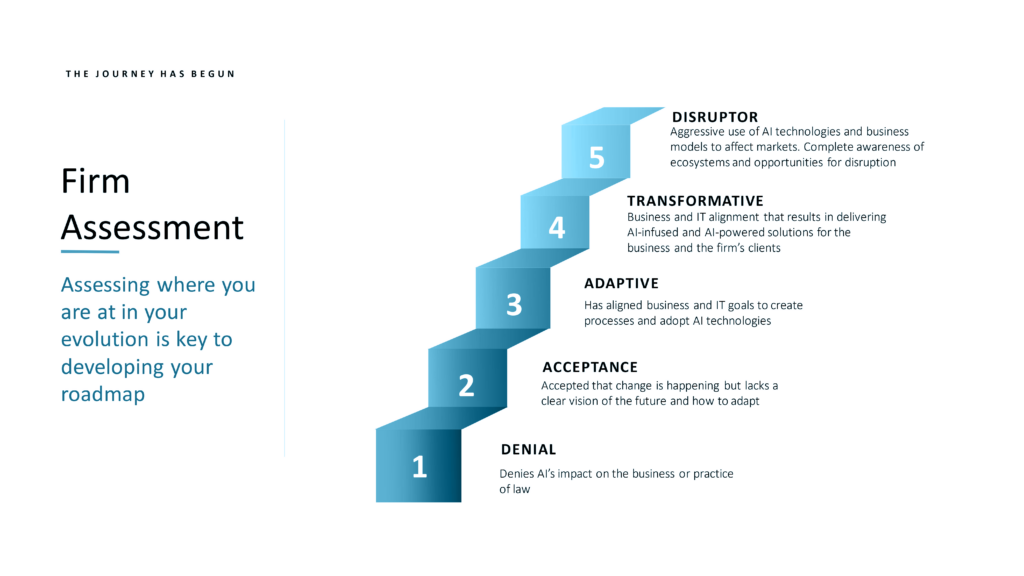
Firm assessment
To succeed with AI, you really do need to understand where your firm sits currently, so you can understand the next step. Doing a value assessment is about getting people to a point where they’re adaptive, have objectives in mind, and they know where AI will impact their specific department and they’re starting to move in that direction.
Denial
It’s very rare to see firms that think AI is never going to help them, but there are individuals who don’t believe that artificial intelligence will be able to reduce the billable hour or impact the practice of law.
Acceptance
This is where people have accepted that AI will either make their lives better or impact their jobs somehow.
Adaptive
Here, there is alignment and a plan for where we are spending the most time, and where AI can have a significant impact on time spent or the ability to increase quality.
Transformative
At this point, you’ve actually deployed AI technologies and changed your processes to incorporate AI where it’s just a natural part of doing business.
Disruptor
These are the Apples of the world, who rolled out the iPhone. ChatGPT is a perfect example of a disruptor. Once you become a disruptor, people are immediately trying to disrupt you. But the firm that gets to this disruptor level will have a massive lead.
—

Developing Your AI Roadmap: Data Strategy

Tom Baldwin
Founder & CEO
Entegrata
What should a firm start thinking about today as it relates to their data and AI?
We think of data as the plumbing. You can’t have a hot tub without hot water, and with AI we’re sort of leapfrogging into the hot tub without having hot water first. In terms of building the foundation for AI, lots of times when you move past the use cases that are work product-specific, you need access to data. This mean’s all the firm’s data. Not just select documents.
We’re seeing more and more firms recognize that and wonder how to get started. It can be a daunting task, because you can do almost anything with data. What I have found to be successful is that, regardless of your role at the firm, you need to understand the firm’s business strategy and strategic objectives. What’s the firm trying to accomplish?
The firm might have a written plan. If they don’t, then try and get in front of a few leaders and spend 20-30 minutes with them. Ask them what challenges or opportunities they see the firm trying to address, tackle or take advantage of in the market. At this stage, just ask them open-ended questions – not related to technology.
Once you get that list, pick two or three that you can influence or support with data strategy and AI. Use that to ground your efforts.
Lots of people don’t know where to start, and it feels very daunting, especially when you don’t have a way to narrow your focus. By grounding your approach alongside the firm’s strategic business objectives, you do a few of things:
1. Most importantly, if you align yourself with that strategy, you’ll get built-in support for those initiatives. If you say to your leadership “We want to do X because it’s going to help support this key business objective that’s really important to the firm,” it’s much easier to get buy-in and support – financial or otherwise. Compared to saying “Hey, I went to this conference and I saw this really whizbang tool and I think we should buy it because it’s cool.”
2. This approach also forces you to narrow your focus. Oftentimes folks never get going because they don’t know even know where to begin. So you’re just going to pick one part of data and support it.
3. Lastly, this approach gives you the option to say no. Most people I talk to get a request every week from a partner on something AI- or data-related, and it’s hard to say no to a partner. Particularly one with a lot of influence – political or otherwise. It’s much easier to push back if what they’re asking for is not in service of one of these two or three key business objectives. It forces you to use that as a filter for every project. Because you can’t do it all.

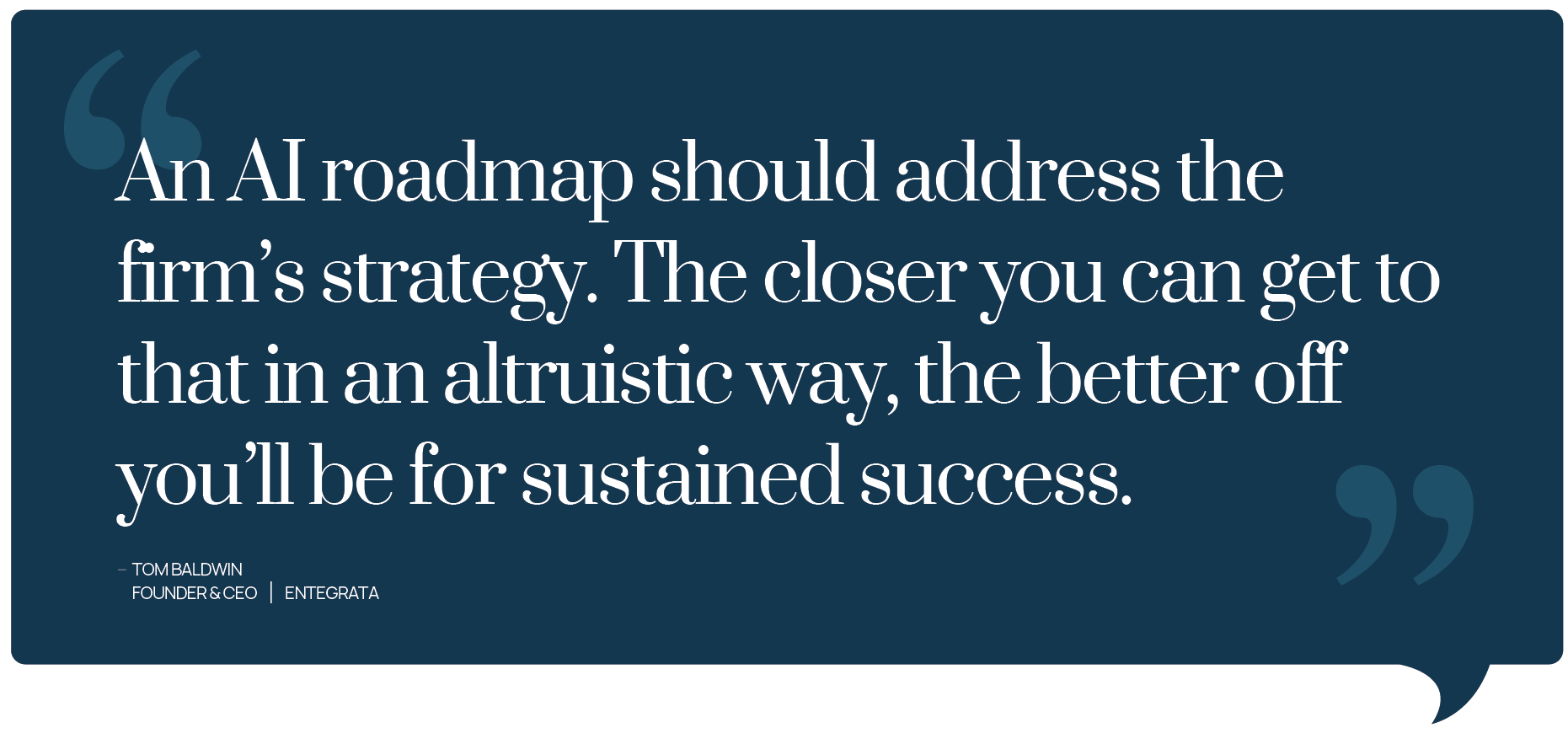
What other departments should we be engaging with and how do we ensure we align with existing initiatives?
Finance has their data. Marketing has their data. HR has their data. But in reality it’s the firm’s data. The only way to break down those siloes is to bring everyone together. When I have done this work in the past, I request that we make this as big a tent effort as possible, and that means we want all the leaders. I want their right-hand folks involved in a kickoff meeting, and I want everyone to come to the table knowing that they’re on equal footing. They all have something to gain from having access to data. They all have something to contribute.
While they may not be part of the initial set of projects that are aligned with the firm’s strategy, they need to be aware that this is happening. Every time I’ve done one of these, there’s always this aha moment where you see the light bulb go off in someone’s mind, because they didn’t really think about data in a broader context before. They thought about it in their own universe, but they didn’t know what they didn’t know.
People realize that they’re doing the exact same thing and duplicating efforts, or they didn’t know the firm strategy was aligned there. It helps people see they can do things slightly differently in their groups. It also helps start the process of breaking down walls, instead of groups trying to hoard their data. If they understand the initiatives that are being driven through data are in support of firm-wide business objectives, they have a harder time saying no to sharing their data. Some of it is financial, and some of it is political.
When you don’t go through the process and let everyone know you want them involved, you end up alienating folks who don’t feel included, and everybody has data that’s important to the firm. So we want everyone to do it together.
What are some of the top issues we want our roadmap to address?
We see tons of firms rolling out their own branded version of GPT. There’s a lot of hype and interest right now, but if you fast forward a year or two, if you’ve got a plan that’s rooted in firm strategy, the roadmap’s going to be driven from that. That means you’ve got to look at different roles that you currently don’t have people to fill, because it’s a new technology or a skillset we just don’t have. Then you need to go hire those folks.
Data governance is often overlooked, and often conflated with information governance – but they are distant cousins. If you think about the classic big three – people, process, and technology – data governance is all three. There are tools for data governance. If you go back to grounding your strategy in a couple of things that are specific and firm-related, it helps you not try to boil the ocean when it comes to governance.
If you want to improve an initiative such as cross-selling, and you look at people, process and technology around how you onboard, manage, and pitch work, you don’t have to look at the whole universe of things. You just have to look at governance with that lens on, which helps you narrow your focus.
It’s a very simple concept that helps you permeate everything you do from a data and AI standpoint. An AI roadmap should address the firm’s strategy. The closer you can get to that in the most altruistic way, the better off you’ll be for sustained success.
—

These tools are very powerful, but you have to use them in the right way. They are a tool. They are not a solution

Andrew Hutchinson
CEO
Databall
What are some of the top issues we want our roadmap to address?
If you look at the firms trying to deploy AI and the technology companies building AI solutions for law firms… One of the things they’re all trying to do is solve the most complex problem. At the same time,they’re complaining about the potential impact on billable revenue and profitability.
If you’re going to use AI to try and solve for high bandwidth knowledge work, then of course you’re going to impact your rates. But it’s also the hardest problem to solve. Because you’re trying to solve the stuff that is a function of knowledge and experience combined with the situation that you’re trying to deal with on the client side.
I think we are at the top of the Gartner hype cycle and everyone’s frantically trying to figure out what to do with AI. No one seems to be hitting the nail on the head. And just because you have a hammer doesn’t mean everything’s a nail.
The rapid evolution of AI development is happening in the practice of law. In the business of law, I find there is less investment, less consideration for it and people are sort of glossing around the edges. Nothing I’m seeing is really fundamental in terms of changing the way we think about marketing and business development.
In the adoption of AI, its quite interesting how people think about the problems they’re solving. Firms aren’t actually using data about the problems that they have to figure out how they prioritize the problems that they solve with AI. So you’re going and throwing AI to try and solve problems, but how do you know it’s an actual problem? Is it the sort of problem that is causing you to write off a lot of billable time? If it is, that’s a valuable area of focus.
I think the partners in law firms realize that for the first time, large language is a threat to their business. And if they can try and take control of the narrative quickly, then that’s potentially advantageous to them.

Gartner Hype Cycle
What are the major opportunities for GenAI?
Summarization is where large language really has its strengths right now. If you think about a partner meeting with a client, AI can do a great job of summarizing what’s going on with that client.
We work with a company that has built some technology around external content, looking at things like company filings. And they’re using large language to automatically create summaries of that information. As a partner, I can press a button and within two paragraphs, I’ve got a summary of everything I need to know. I might say: “Tell me everything that’s happened in the news in the last three months, related to this client that I care about as a partner who’s focused on corporate law.”
I think there’s also potential to use the power of large language to figure out where there might be opportunities for work. Using the news as a trigger to say, it looks like Peloton (for example) is having challenges. They’ve got revenue issues that are leading to a potential restructuring around resources. We should probably go to the restructuring practice and talk to them about how they can think about restructuring their business to continue to move forward.

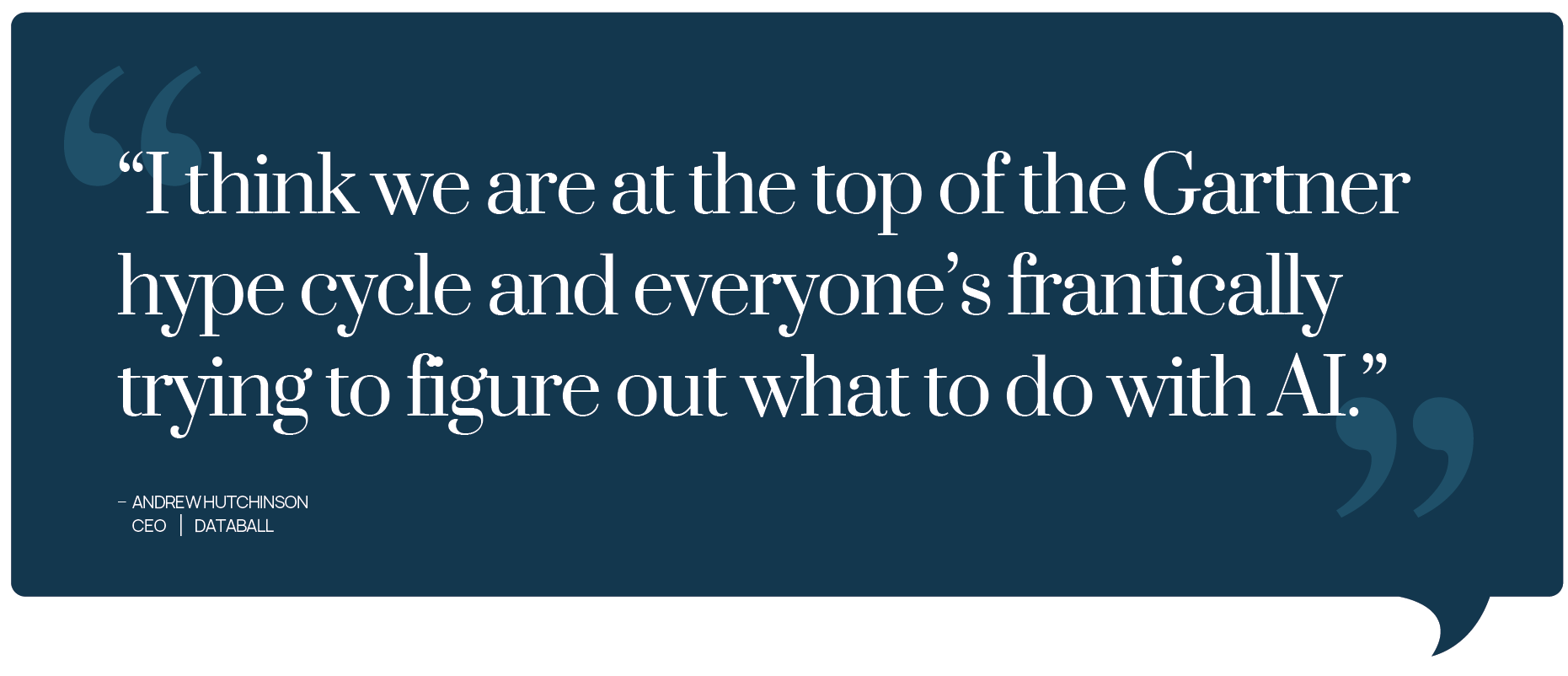
Those are the sorts of things that large language can do. There’s a lot of talk about using large language for the creation of content. But if you read enough LinkedIn articles, people are already bored of generic content and it loses a lot of value.
The counter to that is, I’m a dyslexic person. Large language is great for me. I can write something, and it’s got my construct and my thoughts, and can turn it into something that the average person can read. I think it’s also relevant in the context of lawyers, when writing thought leadership isn’t something they’re necessarily experienced at. If used appropriately, those tools can be very powerful in that context.
I don’t think it’s a good idea to get large language to write our proposals for us because winning business is all about the personal touch. It’s about understanding your client and being very intentional in the way that you communicate. I think there is some merit there, but people need to be careful that they’re not just creating generic content.
Extracting value from business plans
One of the challenges firms have faced in marketing and business development for years is extracting value from business plans. We all know that partners create business plans and nobody ever looks at them ever again.
But there’s some thought and really powerful insights that went into those. I’ve worked with a bunch of firms who’ve tried to systematize that. So let’s take our business plans and put them into a database where we can actively use them.
My belief is that large language presents us an opportunity to leave the lawyers where they are. No one likes changing lawyer behavior because it doesn’t fundamentally work. You can change it for a period but, like an elastic band, it will always revert back to where it started. That’s just the way humans are in the context of things that they aren’t necessarily skilled at.
The beauty of something like large language is it allows you to leave those documents where they are, but start to extract the value. I can now go along and say, “Who are the partners that included Royal Bank of Canada in their business plan? Great, these are the people. Now let’s work with them to build a strategy to go get more revenue out of Royal Bank of Canada.”
That’s another strong opportunity to take advantage of something that partners do every year, and to gain value without having to change behavior.
—
AI Creation with fSquared Marketing

The Potential and Limitations of AI-Generated Video

Peter Figaniski
Art Director
fSquared Marketing
I strongly believe that with the surge of AI, marketers today have access to amazing generative tools they can use to complement and enhance their work. Current AI tools fall into three main categories: text generation, image generation, and video generation. Each of these come in a variety of platforms, such as the well-known and often-used ChatGPT for text and images.
As powerful as these AI-generated tools are today, it’s also important to realize that they are at their worst capabilities now. Innovation is happening constantly, and these tools will only get better and better with time. Having said that, for marketers wanting to use AI tools today, they are not equal for all media. While text-generation and image-generation tools are rapidly improving, video is the least mature product by far – and has the most limitations. The promise of AI-generated videos is high, but in most cases what’s available today is not ready for general use.
Three key aspects currently control the limits of AI video: sophistication, availability, and editability.
When compared to mature products like the text-generating ChatGPT, video creation today produces results that may contain obvious glitches and mis-renders. This is especially true when dealing with videos that contain people. It’s common for AI tools to render extra fingers, unrealistic faces, and unnatural movements. Video is a complex and multi-layer medium, so the sophistication of these AI tools – while improving all the time – still leaves lots to be desired at the moment.
The second aspect to consider is the availability of these video-generating tools. Most of them (especially the newer and more powerful ones) are currently either invitation-only test versions for developers, or early beta versions available to select members of the public. By contrast, text-based generators are free and widely available to the general public. Of course, this will change over time, but marketers wanting these tools today will find limited options available to them.
Finally, a significant barrier to marketers now (and likely in the future) is the nature of video editing. Unlike text generated by ChatGPT or AI-generated images, editing a video is inherently a much more prohibitive process. Even for non-AI generated content, video-editing is a more complex and skill-specific task. We have limited control of the exact video that’s generated by AI. In order to edit videos to achieve the intended result, I believe challenges will exist for marketers wanting to use AI-generated videos in their everyday efforts.
Despite some of these current and near-future limitations of AI-generated videos, I still think there is promise for them in marketing, but possibly to a lesser degree than AI-generated text or imagery. The next few years should offer some new and innovative tools in this field that everyone is excited to keep their eyes on.
—

AI in Graphic Design: Transforming Creativity and Boosting Productivity

Tara Troch
Graphic Designer
fSquared Marketing
Even as a seasoned graphic designer, I cannot deny that AI creates some impressive content. AI-generated results continue to improve. However, it can still be noticeable that a design has been built with AI, particularly when it comes to hands, faces, and anything involving people and emotions. Humans become less human and can be uncomfortable to look at. AI is a much better tool when used to create elements that can be used in your existing planned designs, helping you streamline your processes.
AI has become increasingly relevant in our daily lives, particularly in creative fields like graphic design. As graphic designers, we face a choice: Fear these new tools or harness their power to elevate our work.
AI can be incredibly useful, yet it raises several questions and concerns, particularly around productivity and legal issues. A large concern is whether AI-generated images are derived from copyrighted materials, potentially leading to legal issues. Many AI models are trained on extensive datasets, which might include copyrighted images without proper licensing. This raises significant legal and ethical questions.
Designers need to be aware of this and choose AI tools that are transparent about their data sources and ensure proper licensing. Even if an AI generates a new image, it might closely mimic existing copyrighted works, potentially leading to intellectual property infringement issues. In my opinion, the best work always comes from a team of creative specialists.
AI can enhance productivity significantly if used correctly. It can handle repetitive tasks, generate rapid prototypes, and create design elements, freeing up time for more creative endeavors. AI can speed up tasks like resizing images, adjusting color balances, and creating multiple design versions, allowing designers to focus on more creative aspects of their work. When prompted with your initial design, AI can generate multiple options for that concept, which can be helpful in the planning stage. For non-critical design elements like icons or background textures, AI can generate assets that save time and effort. AI can also help organize and manage design projects, track deadlines, and suggest efficient ways to structure work, enhancing overall productivity.
The more knowledgeable and adept you become at using AI, the stronger you will be as a graphic designer. It is not the AI itself that poses a threat to jobs, but rather the designers who fail to integrate AI effectively into their workflows. By balancing AI assistance with your own creative expertise and maintaining awareness of legal considerations, you can harness AI to enhance productivity, generate innovative designs, and streamline workflows.
Those who use AI as their creative partner, rather than a crutch, will find themselves at a significant advantage in the industry.
—

Content Creation Powered by People and AI

Jenny van Enckevort
Content Specialist
fSquared Marketing
As a writer and content specialist, I use large language model (LLM)-based AI as a creative and practical tool – not an automated solution.
Sometimes I use AI as a creative partner the way a painter uses a palette. For example, I might ask an app to give me 500 words about a certain topic. My final creation will not look anything like those first 500 words, but I’ll use them to get my creative process started. This is a bit like a painter filling a blank canvas with a solid colour. Instead of staring at a sea of white, now there’s a starting point.
As I edit and tailor my AI prompts, I may copy different bits of text from the app and paste them into a source document that includes ideas from’ news articles, social media posts, verbal brand documents and my own ingenuity. This is where I blend ideas and create new ones. It’s a bit like mixing paints before applying them to a canvas where I’m giving shape to something new.
My palette is filled with words that are both my own and not my own, but whatever makes it onto the final canvas is original, quality-checked content, free of copyright infringement. Creatively speaking, the main problems I address with AI are: a blank canvas, an empty palette, a need for inspiration, and saving precious time.
From a practical perspective, LLM-based AI has its uses as well as its limitations. You might find it most useful to help solve a series of simple problems, rather than tackling the most complex content-creation problems.
Word processors have evolved with machine learning tools to help us check spelling and grammar, and predict text. We’ve been using AI all these years – possibly without even realizing it. Now, with large language models, you can ask for help with prompts such as:
- Rewrite my content in the active voice.
- Change this document to the first person plural.
- Use second person instead of third person.
- Change this paragraph to a grade 8 reading level.
- Remove jargon.
- Update this content for 2024.
- Write three social media posts from this article.
The more you practice, the better you’re likely to get at generating prompts that meet your marketing goals. But whatever the output, you may still need to compare the content to specific style guides – as well as existing content – to ensure the voice, tone and style align with a firm’s brand.
AI can sometimes help with simple tasks such as editing a piece of writing to use Canadian or American spellings. You can also ask it to match certain aspects of Associated Press Style or Canadian Press Style, when you provide an in-house style guide for comparison. It can even show tracked changes, to help check the app’s work. This is a good thing because the results are not always reliable. For example, it may inaccurately “fix” subject-verb agreement, or incorrectly capitalize words that should be lower-case.
There may be times when you use the AI app’s summarizing power to help understand a complex legal case from FindLaw.com or CanLii.org. There are other times when the results are AI hallucinations – and it produces a response that has absolutely nothing to do with the case provided.
Ultimately, working with LLM-based AI is like having a conversation where the quality of the dialogue depends on both partners. As content creators, we have to bring experience, knowledge, creativity and skill to all interactions with AI to ensure we’re producing original, accurate and quality work.
—

